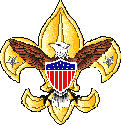| MERIT BADGES |
|
|
|
|
| Note: Eagle Required are in Italics |
"A"
American
Business
American Culture
American Heritage
American Labor
Animal Science
Archaeology
Archery
Architecture
Art
Astronomy
Athletics
Atomic Energy
Auto Mechanics
Aviation
"B"
Backpacking
Basketry
Bird Study
Bugling
"C"
Camping
Canoeing
Chemistry
Cinematography
Citizenship
Community*
Citizenship Nation*
Citizenship World*
Climbing
Coin Collecting
Collections
Communications*
Computers
Cooking
Crime Prevention
Cycling*
"D"
Dentistry
Disability Awareness
Dog Care
Drafting
"E"
Electricity
Electronics
Emergency
Preparedness**
Energy
Engineering
Entrepreneurship
Environmental
Science*
"F"
Family Life*
Farm Mechanics
Fingerprinting
Fire Safety
First Aid*
Fish & Wildlife Mgmt.
Fishing
Fly Fishing
Forestry
"G"
Gardening
Genealogy
Geology
Golf
Graphic Arts
"H"
Hiking
Home Repairs
Horsemanship
"I"
Indian Lore
Insect Studies
"J"
Journalism
"K"
"L"
Landscape Architecture
Law
Leatherwork
Lifesaving**
"M"
Mammal Study
Medicine
Metalwork
Model Design & Building
Motorboating
Music
"N"
Nature
"O"
Oceanography
Orienteering
"P"
Painting
Personal Fitness**
Personal Management*
Pets
Photography
Pioneering
Plant Science
Plumbing
Pottery
Public Health
Public Speaking
Pulp and Paper
"Q"
"R"
Radio
Railroading
Reading
Reptile & Amphibian Study
Rifle Shooting
Rowing
"S"
Safety
Salesmanship
Scholarship
Sculpture
Shotgun Shooting
Skating
Skiing
Small Boat Sailing
Soil & Water
Conservation
Space Exploration
Sports**
Stamp Collecting
Surveying
Swimming**
"T"
Textile
Theatre
Traffic Safety
Truck Transportation
"U"
"V"
Veterinary Medicine
"W"
Water Skiing
Weather
Whitewater
Wilderness Survival
Wood Carving
Woodwork
"X"
"Y"
"Z"
 Emergency
Preparedness*
Emergency
Preparedness*Requirements 1995 |
- Earn the First Aid merit badge.
- Do the following:
- Tell what you would do to prevent injury and possible loss of life to yourself and others in each of the following emergencies: fire or explosion at home and in a public building, car stalled in a blizzard or desert, motor vehicle accident, mountain accident, food poisoning, boating accident, search for lost person, lost or marooned group, gas leak, earthquake, flood, tornado or hurricane, atomic emergency, and avalanche (snow or rock).
- Show that you know what to do in at least TWO of the above.
- Show how you could safely save a person from the following:
- Touching a live electric wire
- A room with carbon monoxide or other fumes or smoke
- Clothes on fire
- Drowning using nonswimming rescues (including ice accidents)
- Tell the things a group of Scouts should be prepared to do, the
training needed, and the safety precautions to be taken for the following emergency
service:
- Crowd and traffic control
- Messenger service and communication
- Collection and distribution services
- Group feeding, shelter, and sanitation
- Take part in an emergency service project, either real or a practice drill.
- Show three ways of attracting and communicating with rescue planes.
- With another person, show a good way to move an injured person out of a remote and rugged area, conserving the energy of the rescuers.
- Do the following:
- Prepare a written plan for mobilizing your troop when needed to do emergency service. If there is a plan, explain it. Tell your part in making it work.
- Take part in at least one troop mobilization. Describe your part.
- Show the personal "emergency pack" which you have prepared to be ready for a mobilization call. Show a family kit (suitcase or box) for use by your family in case an emergency evacuation is needed. Explain the need.
- Show proper use of ropes and lines for rescue work by doing the
following:
- Tie knots for joining lines. Tie knots for shortening or adjusting lines. Tie knots for lashings.
- Lower a person from a height sufficient to show how.
- Coil and accurately throw light and heavy 50-foot heaving lines.
|
||||||
Last Update May 15, 2023

.jpg)
